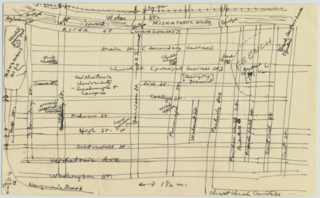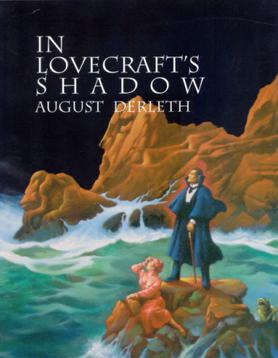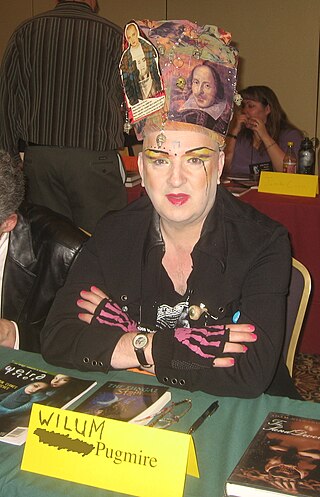
The Cthulhu Mythos is a mythopoeia and a shared fictional universe, originating in the works of American horror writer H. P. Lovecraft. The term was coined by August Derleth, a contemporary correspondent and protégé of Lovecraft, to identify the settings, tropes, and lore that were employed by Lovecraft and his literary successors. The name "Cthulhu" derives from the central creature in Lovecraft's seminal short story "The Call of Cthulhu", first published in the pulp magazine Weird Tales in 1928.

Cthulhu is a fictional cosmic entity created by writer H. P. Lovecraft. It was introduced in his short story "The Call of Cthulhu", published by the American pulp magazine Weird Tales in 1928. Considered a Great Old One within the pantheon of Lovecraftian cosmic entities, this creature has since been featured in numerous popular culture references. Lovecraft depicts it as a gigantic entity worshipped by cultists, in the shape of a green octopus, dragon, and a caricature of human form. The Lovecraft-inspired universe, the Cthulhu Mythos, where it exists with its fellow entities, is named after it.

Arkham is a fictional city situated in Massachusetts, United States. An integral part of the Lovecraft Country setting created by H. P. Lovecraft, Arkham is featured in many of his stories and those of other Cthulhu Mythos writers.

Gahan Allen Wilson was an American author, cartoonist and illustrator known for his cartoons depicting horror-fantasy situations.

Lovecraft Country is a term coined for the New England setting used by H. P. Lovecraft in many of his weird fiction stories, which combines real and fictitious locations. This setting has been elaborated on by other writers working in the Cthulhu Mythos. The phrase was not in use during Lovecraft's own lifetime; it was coined by Keith Herber for the Lovecraftian role-playing game Call of Cthulhu.

Lovecraftian horror, also called cosmic horror or eldritch horror, is a subgenre of horror fiction and weird fiction that emphasizes the horror of the unknowable and incomprehensible more than gore or other elements of shock. It is named after American author H. P. Lovecraft (1890–1937). His work emphasizes themes of cosmic dread, forbidden and dangerous knowledge, madness, non-human influences on humanity, religion and superstition, fate and inevitability, and the risks associated with scientific discoveries, which are now associated with Lovecraftian horror as a subgenre. The cosmic themes of Lovecraftian horror can also be found in other media, notably horror films, horror games, and comics.
Whispers was one of the new horror and fantasy fiction magazines of the 1970s.
"To Arkham and the Stars" is a short story by American writer Fritz Leiber, belonging to the Cthulhu Mythos genre of horror fiction. It was written for the 1966 Arkham House anthology The Dark Brotherhood and Other Pieces. Set in H. P. Lovecraft's Arkham and Miskatonic University, it includes characters from and allusions to several Lovecraft stories.
Peter H. Cannon is an H. P. Lovecraft scholar and an author of Cthulhu Mythos fiction. Cannon works as an editor for Publishers Weekly, specializing in thrillers and mystery. He lives in New York City and is married with three children.
A Cthulhu Mythos anthology is a type of short story collection that contains stories written in, or related to, the Cthulhu Mythos genre of horror fiction launched by H. P. Lovecraft. Such anthologies have helped to define and popularize the genre.

The Watchers Out of Time and Others is an omnibus collection of stories by American writer August Derleth, inspired in part by notes left by H. P. Lovecraft after his death and presented as a "posthumous collaboration" between the two writers. It was published in an edition of 5,070 copies. Several of the stories relate to the Cthulhu Mythos and had appeared previously in the earliest collections The Lurker at the Threshold, The Survivor and Others, The Shuttered Room and Other Pieces, The Dark Brotherhood and Other Pieces and other Arkham House publications.

Gary Clayton Myers is an American writer of fantasy and horror. He is a resident of Fullerton, California.
Richard Louis Tierney was an American writer, poet and scholar of H. P. Lovecraft, probably best known for his heroic fantasy, including his series co-authored of Red Sonja novels, featuring cover art by Boris Vallejo. He lived the latter part of his life in Mason City in the great Corn Steppes of Iowa. Some of his standalone novels utilize the mythology of Lovecraft's Cthulhu Mythos. He is also known for his Simon of Gitta series and his Robert E. Howard completions and utilisation of such Howard-invented characters as Cormac Mac Art, Bran Mak Morn and Cormac Fitzgeoffrey.
James Allen Turner was an American editor and publisher. Turner was editor for Arkham House after the death of August Derleth. After leaving Arkham House, he founded Golden Gryphon Press.

In Lovecraft's Shadow: The Cthulhu Mythos Stories of August Derleth is a collection of fantasy and horror short stories by American writer August Derleth. It was released in 1998 by Mycroft & Moran in an edition of 2,051 copies.

Wilum Hopfrog Pugmire, was a writer of weird fiction and horror fiction based in Seattle, Washington. His works typically were published as W. H. Pugmire and his fiction often paid homage to the lore of Lovecraftian horror. Lovecraft scholar and biographer S. T. Joshi described Pugmire as "the prose-poet of the horror/fantasy field; he may be the best prose-poet we have" and as one of the genre's leading Lovecraftian authors.
"Black Man with a Horn" is a horror novella by American writer T. E. D. Klein. It is a part of the Cthulhu Mythos cycle, and was originally published in New Tales of the Cthulhu Mythos. Critic S. T. Joshi notes that the story demonstrates a "deftness of style, a subtlety in the build-up of a horrific climax, and a deep understanding of the psychological effects of horror."

Joseph Vernon Shea (1912–1981) was an American writer of horror, fantasy, poetry, and essays; and a correspondent of H. P. Lovecraft, Clark Ashton Smith, and August Derleth.

Awaiting Strange Gods: Weird and Lovecraftian Fictions is a collection of dark fantasy and horror short stories by American writer Darrell Schweitzer. It was first published in hardcover and trade paperback by Fedogan & Bremer in September 2015.










